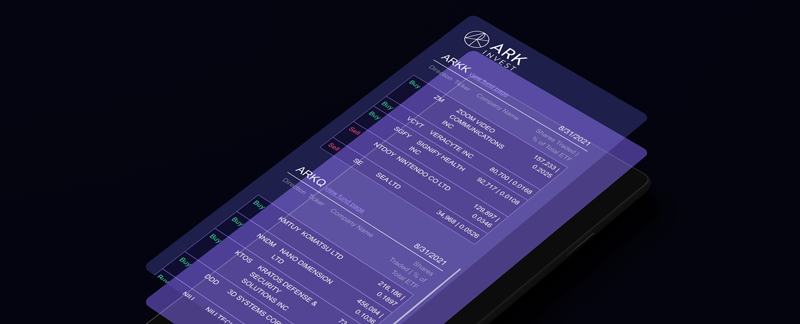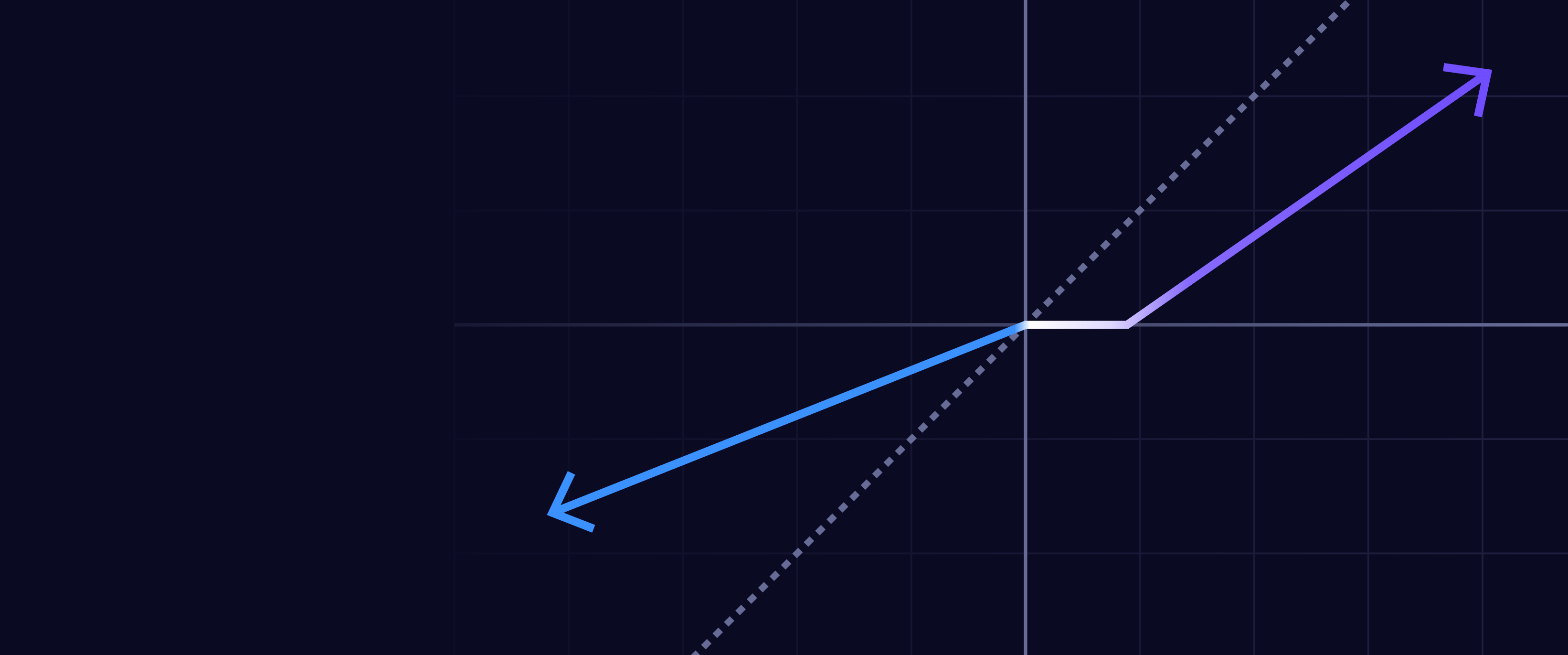“Always water your horse upstream from the herd.”
Ask most investors to define risk, and they’ll point to a number—standard deviation, a backward-looking statistic that measures how much a stock’s price has fluctuated relative to its mean over a stated period.1 In our view, that number misses an important character in the full story of risk: owning stock in a business that might be becoming irrelevant.
Indeed, asset allocators should scrutinize the tendency to conflate volatility and risk, not just because volatility will rise during a period of large-scale disruption, but also because standard deviation is measured over shorter time frames that may be incompatible with long-term wealth building. The certainty of past price stability does not guarantee safety, in other words, and in our view the volatility associated with disruption is not tantamount to fragility.
In fact, to some degree, volatile stock movements may reflect disruptive potential, because markets are trying to anticipate a company’s future value. That said, markets have become increasingly short-term in focus. As a result, standard deviation—again, a backward-looking statistic—fails to capture the longer-term existential threats that determine whether a company will survive the next wave of innovation. An asset whose price is collapsing smoothly might be a risky asset to hold, despite a low standard deviation. Consider Ford relative to Tesla: the former appears statistically “safer” on paper—retrospectively, at least—but is it likely to be disrupted over the next business cycle? Readers know where ARK stands!
In today’s environment, we believe the real risks are discernible not in price charts but in companies’ business models. From that standpoint, companies whose standard deviations make them appear “stable” on paper may be structurally fragile: they are clinging to legacy systems, outdated distribution techniques, or regulatory moats that are no longer relevant. Meanwhile, firms whose books reveal that they are building the future often show short-term volatility as they invest aggressively in innovation, talent, and long-term scale. So, when we are gauging risk, we are looking at factors that include technological obsolescence, strategic inertia, and failure to adapt to shifting consumer behavior. In that context, the “riskiest” companies in our eyes often are those that look the most “stable” to traditional allocators. The real danger lies not in short-term fluctuations but in long-term irrelevance.
For investors, we believe the implications should be clear: the world sits on the cusp of a technological revolution and traditional risk frameworks are not sufficient. By relying on standard deviation or beta,2 many portfolios underweight tomorrow’s innovators and overweight yesterday’s news. Said differently for effect, many portfolios cling to the comfort of benchmarks and are inadvertently short innovation. The “safe-bet” asset allocators might believe they’re reducing risk by tilting their clients’ portfolio’s toward “low-vol” sectors; in practice, they may be allocating their clients’ capital into obsolescence.
In our view, the concentration of assets into benchmark-tracking strategies over the last decades has created a false sense of security through an overreliance on the perceived stability of mega-cap3 holdings. Can historical stability really offer meaningful protection, when business models are being reimagined in real time, or when timeframes for measuring risk ignore where future value is being created and destroyed?
To build durable portfolios in a disruptive world, we want investors to know that they have access to companies that have a new playbook, one that incorporates innovation dynamics, network effects, data scale, and adaptability. Investing in such companies involves looking beyond short-term price behavior and asking probing questions about where future value will be created and where it will be destroyed. It means looking at the investment opportunity through a medium- to long-term horizon to assess what is most attractive.
That is how ARK manages our investment strategies. Our portfolios seek exposure to the disruptive technologies and platforms reshaping the future. Because during a technology transformation, managing risk starts with asking the right question: which companies will lead, and which companies will be left behind?
Appendix A: Examples In Which “Standard Deviation” Misled Investors While Structural Risk Compounded
The disconnect between statistical risk and real business risk is evident across sectors and history:
- Netflix versus Blockbuster: In the late 1990s, Reed Hastings made it clear that Netflix’s long-term ambition was to become a streaming platform, but the bandwidth simply wasn’t there yet. Meanwhile, Blockbuster had every advantage: market dominance, brand recognition, and cash flow. Netflix went public in 2002, quietly building its subscriber base and tech stack while Blockbuster coasted, unfazed by the disruptive potential of a company with a market cap just 1/20th its own. Standard deviation never signaled the real risk. Blockbuster looked stable until it wasn’t. Netflix looked volatile, but it was building the future.
- Traditional Auto Manufacturers versus Tesla: Tesla’s electric vehicles have steadily cut into the market share of traditional automakers. Legacy original equipment managers (OEMs) like Ford and GM face a classic innovator’s dilemma: scaling electric vehicle production requires massive investment, but doing so would compress their margins and upset shareholders. As a result, most incumbents move cautiously, protecting near-term profits at the expense of long-term relevance. Meanwhile, Tesla has invested aggressively, not only in manufacturing, but also in autonomous mobility capabilities and the infrastructural foundation for its robotaxi network. Standard deviation might suggest Ford is the “safer” stock, but the real risk lies in underestimating Tesla’s structural disruption.
- Traditional Banks versus Fintech and Decentralized Finance (DeFi): Traditional banks still benefit from regulatory protection, broad distribution, and consumer stickiness. But that surface-level stability masks a foundational shift underway. Platforms like Robinhood and Coinbase make it easier than ever to invest, while decentralized finance applications built on smart contract platforms like Ethereum and Solana are rebuilding core financial services without intermediaries. By removing the middlemen, those systems pass savings directly to the consumer; and they offer lower access points, lower fees, faster settlement, and 24/7 access—all of which expand total addressable market (TAM). The result is a fully functioning bank branch in your pocket. For traditional institutions, that creates a growing liability: thousands of brick-and-mortar locations turning into stranded assets. Banks may appear less volatile, but their infrastructure is aging fast.
- Intel versus Nvidia: Intel once was the dominant force in semiconductors, setting the standard for compute performance and scale. In contrast, Nvidia often appeared risky, especially during the 2017-2018 and 2021-2022 crypto boom-and-bust cycles that drove sharp swings in its stock. Beneath the volatility, however, Nvidia was quietly building one of the most strategically important businesses in technology, now powering artificial intelligence (AI) models, data centers, and high-performance computing infrastructure. Intel’s stock may have looked more stable, but the company has fallen behind in architecture, manufacturing, and speed of innovation. Once again, standard deviation missed the big picture.
- Legacy Software versus AI-Native Tools: Enterprise software incumbents, such as those offering enterprise resource planning and analytics, have long benefited from entrenched clients and predictable revenue. Now, a new generation of companies is rebuilding workflows around AI-native platforms. Take Palantir, for example. Executives recently shared that their AI Platform reduced underwriting times for an insurance client from two weeks to just three hours, one of the many cases in which AI is driving a step-change in productivity. On paper, legacy software providers might look safer. According to our research, their inability to internalize AI at scale is a far greater risk than any short-term stock wobble.
- Traditional Pharma versus AI-Native Multiomic Platforms: For decades, large pharmaceutical companies have relied on slow, trial-and-error research and development (R&D) to drive drug development, often outsourcing innovation or acquiring it after the fact. Their pipelines depend on incremental advances and blockbusters that take years and billions of dollars to reach the market. In contrast, a new generation of AI-native multiomic platform companies is redefining how disease is detected, treated, and even cured. These companies integrate multiomics, automation, and AI to accelerate discovery, lower costs, and personalize medicine at scale. While legacy pharma may look “defensive” on paper, the real risk lies in missing the shift toward data-driven, platform-based biology. In a world moving toward curative therapies and faster innovation loops, traditional drug development is looking more and more like a stranded, outdated model.
Appendix B: Illustrative Comparisons Of Standard Deviation Versus Return 2021-2025
Annualized Standard Deviation And Return (7/30/2021 – 7/31/2025)
| Company | Standard Deviation | Return (%) |
| Tesla | 75.29 | 8.08 |
| Ford Motor Company | 47.88 | -0.32 |
| General Motors | 45.05 | -1.00 |
| Robinhood Markets | 89.96 | 31.11 |
| Coinbase Global | 107.98 | 12.49 |
| Bank of America | 33.40 | 7.81 |
| JPMorgan Chase | 30.00 | 21.12 |
| Nvidia | 66.25 | 73.39 |
| Intel | 54.78 | -20.30 |
| Palantir Technologies | 82.61 | 63.35 |
| Workday | 45.47 | -0.63 |
| SAP SE | 32.74 | 20.47 |
| Oracle | 41.70 | 32.25 |
| International Business Machines (IBM) | 28.14 | 22.14 |
| CRISPR Therapeutics | 73.58 | -17.06 |
| Intellia Therapeutics | 86.84 | -45.97 |
| Beam Therapeutics | 90.18 | -31.63 |
| Recursion Pharmaceuticals | 118.22 | -34.48 |
| Absci | 116.02 | -43.84 |
| Pfizer | 31.29 | -9.75 |
| Johnson & Johnson | 20.67 | 1.80 |
| S&P 500 Index | 21.54 | 11.08 |
Please note: 4-year standard deviation and return numbers are shown instead of the more widely used 5-year time period because Coinbase, Robinhood, Absci, and Recursion only have a 4-year track record since going public and we want to show properly comparable data. For informational purposes only and should not be considered investment advice or a recommendation to buy, sell, or hold any particular security. Past performance does not guarantee future results. Investors should consult with a financial professional and decide for themselves the appropriate risk-reward tolerance for their portfolio.
Important Information
Investors should carefully consider the investment objectives and risks as well as charges and expenses of an ARK Fund before investing. This and other information are contained in the ARK ETFs’ prospectuses and summary prospectuses, which may be obtained by visiting www.ark-funds.com. The prospectus and summary prospectus should be read carefully before investing.
An investment in an ARK Fund is subject to risks and you can lose money on your investment in an ARK Fund. There can be no assurance that the ARK Funds will achieve their investment objectives. The ARK Funds’ portfolios are more volatile than broad market averages. The ARK Funds also have specific risks, which are described below. More detailed information regarding these risks can be found in the ARK Funds’ prospectuses.
The S&P 500 Index is a stock market index tracking the stock performance of 500 of the largest companies listed on stock exchanges in the United States.
The principal risks of investing in the ARK Funds include:
Disruptive Innovation Risk. Companies that ARK believes are capitalizing on disruptive innovation and developing technologies to displace older technologies or create new markets may not in fact do so. Companies that initially develop a novel technology may not be able to capitalize on the technology. Companies that develop disruptive technologies may face political or legal attacks from competitors, industry groups or local and national governments. These companies may also be exposed to risks applicable to sectors other than the disruptive innovation theme for which they are chosen, and the securities issued by these companies may underperform the securities of other companies that are primarily focused on a particular theme.
Equity Securities Risk. The value of the equity securities the ARK Funds hold may fall due to general market and economic conditions. Foreign Securities Risk. Investments in the securities of foreign issuers involve risks beyond those associated with investments in U.S. securities. Health Care Sector Risk. The health care sector may be affected by government regulations and government health care programs. Consumer Discretionary Risk. Companies in this sector may be adversely impacted by changes in domestic/international economies, exchange/interest rates, social trends and consumer preferences. Industrials Sector Risk. Companies in the industrials sector may be adversely affected by changes in government regulation, world events, economic conditions, environmental damages, product liability claims and exchange rates. Information Technology Sector Risk. Information technology companies face intense competition, both domestically and internationally, which may have an adverse effect on profit margins.
Additional risks of investing in ARK ETFs include market, management and non-diversification risks, as well as fluctuations in market value NAV. ETF shares may only be redeemed directly with the ETF at NAV by Authorized Participants, in very large creation units. There can be no guarantee that an active trading market for ETF shares will develop or be maintained, or that their listing will continue or remain unchanged. Buying or selling ETF shares on an exchange may require the payment of brokerage commissions and frequent trading may incur brokerage costs that detract significantly from investment returns.
To view the top ten holdings for ARKK click here.
ARK Investment Management LLC is the investment adviser to the ARK Funds.
Foreside Fund Services, LLC, distributor.
In finance, standard deviation measures the volatility or dispersion of returns of an investment or portfolio. It quantifies how much the actual returns deviate from the average or expected return. A higher standard deviation indicates greater risk, meaning the investment's returns are more spread out and potentially more volatile.
In finance, beta (often denoted by β) measures how a security or investment responds to movements in the overall market. It quantifies the systematic risk, also known as market risk, which is the inherent uncertainty of a security's return due to macroeconomic or market-wide factors.
Mega cap, or mega-capitalization, refers to companies with a market capitalization exceeding $200 billion.
ARK’s statements are not an endorsement of any company or a recommendation to buy, sell or hold any security. ARK and its clients as well as its related persons may (but do not necessarily) have financial interests in securities or issuers that are discussed. Certain of the statements contained may be statements of future expectations and other forward-looking statements that are based on ARK’s current views and assumptions and involve known and unknown risks and uncertainties that could cause actual results, performance, or events to differ materially from those expressed or implied in such statements.

ARK Trade Notifications
ARK offers fully transparent Exchange Traded Funds (“ETFs”) and provides investors with trade information for all actively managed ETFs.








